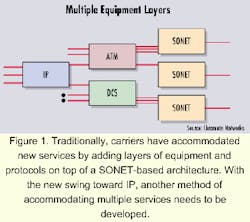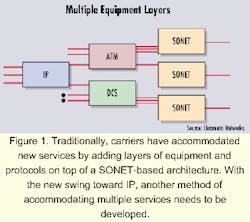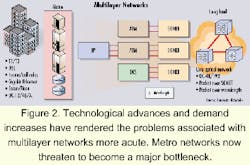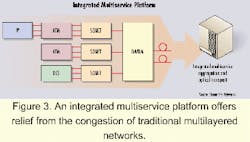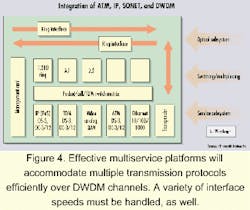SONET, IP, Gigabit Ethernet, DWDM: Which technologies will win?
Actually, it's not whether one technology will win or lose-it's how your network plays the multiservices game.
Lou Martinage
Chromatis Networks
Today, most carrier services, including Internet Protocol (IP), are delivered over a time-division multiplexing- and ATM-based wide-area-network infrastructure running on top of a SONET-based fiber core. This multilayered approach evolved for good reasons, but inherent inefficiencies that were once tolerable are now becoming a barrier to scalability.
While technology advances like DWDM are accelerating the bandwidth potential of the core optical infrastructure, DSL and cable modem services are generating order-of-magnitude increases in subscriber demand for bandwidth.
At the same time, technologies like Gigabit Ethernet are gaining momentum as part of the inevitable migration toward IP convergence. The traditional multiservice overlay systems that were optimized for voice requirements have not kept pace and are becoming a critical bottleneck.There are those who advocate using new optical-networking approaches to scale the traditional ATM- and time-division multiplexing-based infrastructure, while others advocate scrapping it all in favor of a network based purely on IP, Gigabit Ethernet, and DWDM. Is this really an all-or-nothing proposition, or are solutions available that provide carriers with migration strategies for advancing the capabilities of their multiservice aggregation systems, while positioning them for the shift toward more IP-oriented approaches?
Today's multiservice carrier infrastructures evolved through a gradual layering of data-oriented technologies on top of a voice-optimized core network. While all of today's momentum is behind TCP/IP as the protocol for convergence, it's important to recognize that not too long ago, voice support was the primary concern of carriers; TCP/IP was just another data protocol. While some now question the value of technologies such as SONET and ATM in today's IP-dominated environment, it is important to understand the capabilities of these technology tools and appreciate the context in which they were selected.
Back in the 1980s, SONET fundamentally reshaped carrier infrastructures by harnessing the bandwidth capacity of fiber optics, enabling new levels of scalable, manageable, and reliable support for time-division multiplexed (TDM) voice. It introduced the now well-known optical OC-n hierarchy that today can scale to accommodate hundreds of DS-3 streams. It removed the complexity and equipment burden of traditional DS-1/DS-3 voice multiplexing approaches, simplifying the provisioning and management of voice traffic. Finally, with its use of counter-rotating fiber rings, SONET offered unprecedented levels of protection for voice by backing up the "working" traffic sent in one direction with "protected" traffic sent in the other. With these capabilities, carriers could scale their voice services without compromising reliability or manageability.As data traffic emerged in the early 1990s-driven principally by enterprise LAN internetworking-carriers realized that they were wasting valuable TDM bandwidth on LAN traffic that was sporadic in nature. Their solution was to accommodate the statistical nature of data traffic with frame and cell switching approaches that could more efficiently utilize a TDM connection. Technologies like frame relay and ATM emerged on the scene, enabling carriers to "oversubscribe" bandwidth by provisioning multiple logical data connections known as virtual circuits (VCs) over a single physical TDM connection. As carriers rolled out these new data services, they created equipment layers that sat on top of the SONET-based TDM core. A typical metro central office (CO) might resemble the one depicted in Figure 1, with multiple equipment layers for each service offered by the carrier.
Recently, technology developments in virtually all other areas of the carrier network have been placing tremendous new burdens on these traditional SONET-based multilayer systems. Advances in IP routing technology, coupled with innovations in optical networking, are turbo-charging the bandwidth potential in the core of carrier networks. At the same time, evolutions in broadband access technologies are driving order-of-magnitude increases in the demand for bandwidth across metro-access infrastructures. Caught in the middle, between almost infinite capacity in the core and surging bandwidth demand on the edge, is a traditional multiservice networking model that can't keep pace with the developments on either side.
Carrier core networks are undergoing a massive transformation driven by advances in routing and optical technologies. A new generation of routers, tuned to handle TCP/IP, emerged in the late 1990s. With application-specific integrated-circuit-driven forwarding engines and sophisticated route lookup mechanisms, these routers can forward IP packets with latency similar to that of ATM switches. Armed with dense arrays of high-speed interfaces (OC-3 through OC-192), these routers provide the scale necessary to build large, high-capacity IP core networks.
The build-out of the core IP infrastructure has been further accelerated by the deployment of DWDM within the underlying long-haul optical transport systems. With its ability to carry multiple information streams on individual wavelengths over the same physical fiber, DWDM offered carriers an instantaneous opportunity to boost their bandwidth capacity by at least a factor of 10. During the late 1990s, DWDM technology proliferated into the core fiber infrastructures of virtually every major carrier, helping to create a seemingly endless supply of bandwidth in the core.Recognizing that IP is destined to become the common denominator for converged services, carriers will continue to optimize their core networks for efficient, high-capacity IP handling; voice will become just another IP application.
In effect, we are in the beginning phases of turning the traditional core infrastructure "inside out," where instead of supporting data via equipment overlays atop a voice-optimized system, carriers will move toward supporting voice and video as application overlays on an IP-optimized infrastructure. This surge toward IP convergence is also driving the deployment of new technologies on the access side of the network.
Coupled with the explosion of bandwidth in the core infrastructure is an equally impressive acceleration in the bandwidth options at the access edge of the network. Just as DWDM is bringing an infinite supply of bandwidth to the core, technologies like DSL, cable modems, and Gigabit Ethernet are accelerating the demand for bandwidth on the subscriber access side. Combined with these technology developments, the ever-increasing base of Internet subscribers is simply overwhelming traditional multiservice architectures.
Consider that with DSL and cable modem technologies, Internet subscribers are now banging against the carrier access infrastructure with connections that are 100 times faster than traditional 56-kbit/sec dial-up or 128-kbit/sec ISDN connections. At the same time, Gigabit Ethernet is emerging as a leading alternative for corporate access, particularly for multitenant-building infrastructures. Operating at 1 Gbit/sec, Gigabit Ethernet dwarfs the old DS-1 and DS-3 private-line approaches for corporate access. In addition, specialized applications like storage area networks (SANs) are further driving the demand for bandwidth with their use of Gigabit Ethernet and other high-speed connections like Escon, Ficon, and Fibre Channel.
The challenge here is certainly about bandwidth capacity, but it's also about flexibility. Today, DSL traffic is typically aggregated using ATM, while cable modem traffic is typically delivered via Ethernet interfaces. In addition, carriers must accommodate Gigabit Ethernet and face a growing requirement to handle the SAN traffic types. While we have all of these big pipes to accommodate, let's not forget that the vast majority of today's metro-access traffic is still delivered over subrate TDM interfaces.
The traditional multilayer SONET delivery systems in today's metro networks have become the critical path between the seemingly limitless supply of bandwidth in carrier core networks and the surging demand for bandwidth on the subscriber access side of the network. Where these systems were optimized for voice with data as a sort of afterthought, the new requirement is all about data.
As indicated in Figure 2, the challenge for scaling these infrastructures has two faces. On the access side, they must scale to aggregate a wide range of traffic types operating at ever-increasing speeds; on the backbone side, they must be able to hand off the aggregated traffic mix to a supercharged optical infrastructure.
Tuned to aggregate low-speed TDM interfaces, SONET is not efficient when it comes to accommodating data interfaces such as Gigabit Ethernet that do not fit conveniently into SONET virtual containers. For instance, two Gigabit Ethernet connections would consume an OC-48, leaving at least 500 Mbits/sec of stranded bandwidth. The amount of stranded bandwidth may actually be higher, depending on the level of utilization of those Gigabit Ethernet feeds. Efficient packing of the SONET payload for data traffic is a growing requirement as the collective mix of access traffic increases in speed.Perhaps the larger challenge for SONET systems is in scaling the optical transport infrastructure that feeds into the high-capacity optical core. Over the years, SONET rings have slowly evolved from OC-3 and OC-12 to the point where most are operating at OC-48. But given today's high-speed-access alternatives, a 2.5-Gbit/sec shared OC-48 ring can be quickly consumed. While DWDM seems like the obvious answer, cost-effectively migrating it into the metro arena is nontrivial.
While DWDM was the catalyst for the bandwidth explosion within the long-haul optical core, its uptake in metropolitan environments has been limited. DWDM technology fundamentally altered the economics of carrier long-haul systems. Not only were carriers able to "reuse" their entrenched fiber investment, they were also able to realize tremendous operational savings, since DWDM reduced the requirement and expense for the ancillary functions such as regeneration and amplification typically required for long-distance optical transport. With savings in these areas, long-haul providers were able to offset the expense of introducing ex pensive DWDM gear and cost-effectively scale their systems to new heights.
The business case for DWDM in the metro transport environment is much different. With shorter fiber runs, the metropolitan systems do not require the same levels of amplification and regeneration as the long-haul systems did. As such, the business case for deploying DWDM in the metro is as clear-cut as it was in the long-haul space; the expense to deploy DWDM optics is not automatically balanced by savings in other areas. While many DWDM vendors have presented scaled-down versions of their long-haul technology to the metro market, they've been largely ignored. The prospect of an expensive, system-wide DWDM upgrade to accommodate pockets of incremental bandwidth demand is hard for most metro providers to swallow. They need solutions that offer "ready-to-provision" bandwidth without the expense of over-building their entire network with DWDM.
Metro service providers face the daunting challenge of scaling their infrastructures to address the new data-driven bandwidth requirements. With the obvious momentum toward IP convergence and the growing use of packet technologies like Gigabit Ethernet for access, some in the industry suggest supporting this "new growth" area of the metro with solutions that map Gigabit Ethernet and other optical interfaces directly into wavelengths. This approach clearly adds some value, but it does not address the full spectrum of concerns for aggregating metro traffic. While the world is moving toward IP, the bulk of metro-access aggregation traffic is still delivered via ATM and low-speed TDM connections. To scale across the board, metro aggregation solutions must be flexible enough to accommodate a full range of access alternatives and efficiently map that traffic onto the fiber infrastructure.
New metro transport platforms are becoming available that integrate scalable multiservice aggregation with efficient optical transport. As indicated in Figure 3, these systems essentially collapse the job of multiservice aggregation into a single equipment layer. That not only helps carriers preserve existing rack space, but it greatly simplifies management and provisioning. These platforms also address the challenge of scaling the metro fiber infrastructure by providing cost-effective techniques for introducing DWDM optics into the metro environment. As mentioned, DWDM has not been widely accepted in metro environments because traditional long-haul approaches require that expensive DWDM optics be deployed in each node. These new multiservice platforms enable DWDM wavelengths to be turned up on a site-by-site basis so a DWDM investment is only made in those locations with sufficient demand.
From an architectural perspective, an effective multiservice platform would have the following set of characteristics (see Figure 4):
- Wide range of service interfaces: To be effective, multiservice transport architectures must include a wide range of tributary interfaces for collecting virtually any mix of traffic in the metro environment. Maintaining a wide range of interfaces will enable carriers to address today's access requirements, dominated by TDM and ATM, while positioning them for increased support of packet interfaces such as Gigabit Ethernet, in the future.
- Scalable, granular switching fabrics: An essential feature of these platforms is the ability to groom traffic from any interface, independent of protocol type, onto wavelengths. An effective architecture will therefore include nonblocking switching fabrics for IP, ATM, and TDM traffic and be capable of grooming at low levels of granularity. For instance, some platforms can absorb 10-Mbit/sec Ethernet traffic and map that into a selectable number of T1.5 virtual tributaries in the SONET payload, rather than consuming an entire STS-1 45-Mbit/sec channel. Likewise, higher-order platforms can groom at the STS-1 level, enabling data traffic to be packed into an appropriate number of DS-3 containers. With these sorts of integrated switching capabilities, integrated multiservice platforms minimize the stranded bandwidth typical of traditional SONET implementations and even provide opportunities for over-subscription, enabling carriers to more effectively utilize their available capacity.
- Integrated, flexible optics: By integrating optics into the platform, carriers gain tremendous efficiencies in terms of reducing rack space and minimizing management and provisioning complexity. With the optical subsystem tightly integrated with the switching matrices, these architectures ensure that wavelengths will be fully packed with multiservice traffic. In addition, these systems reduce the cost of entry by combining low-cost, off-the-shelf 1,310-nm optics with options for turning up 1,550-nm DWDM wavelengths on an as-needed basis. Metro providers can begin with a low-cost, shared 1,310-nm ring operating at OC-48, then turn up additional 1,550-nm OC-48 DWDM wavelengths on a site-by-site basis as requirements dictate.
It's not really a question of which technologies will win, but of where they will be used in the carrier networks. Some propose that carriers shift to IP-over-optics solutions that remove the middle layers of ATM and SONET, but those approaches won't be complete for some time. While great strides have been made with the IP protocol, enhancements like MPLS and DiffServ still must be completed and proven before carriers will consider IP a viable multiservice protocol; ATM will continue to be used by those carriers with multiservice transport requirements. In addition, the optical community has yet to standardize on techniques that would obviate the need for SONET protection. Today, as carriers are building out the next-generation IP routing core, their gigabit/terabit routers are generally connected using packet-over-SONET interfaces (OC-48, OC-192) running over lambdas; SONET will be around for a long time to come.
Certainly in the metro-access arena, TDM and ATM technologies will have a continued role in the foreseeable future, since the majority of access interfaces run over low-speed TDM pipes, and DSL has given new life to ATM. At the same time, Gigabit Ethernet, which has dominated campus backbone networks, will continue to gain in popularity as a metro-access interface option.
What is important, particularly for the metro environment, is that carriers have the flexibility to accommodate and adapt to new technology tools as requirements continue to evolve. With integrated multiservice aggregation and optical transport platforms, carriers can accommodate any mix of technologies with the flexibility of scaling their optical capacity on an as-needed basis. They can address today's business opportunities while positioning themselves for the new services of the future.
Lou Martinage is director of product marketing for Chromatis Networks (Herndon, VA), which was recently acquired by Lucent Technologies.
